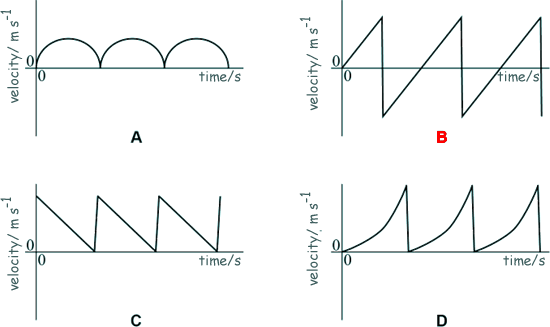Dynamics - Including Equations of Motion Q1. The velocity–time graph for a falling object is shown.
Which of the following shows the corresponding acceleration–time graph?
Choice B is the correct answer. Q2. A girl jogs at 2.0 m s–1 in a straight line for 30 seconds, turns around and returns to her starting point 20 seconds later. What is her average velocity and average speed?
Velocity is zero as she is zero distance from her starting point. distance travelled one way = 2.0 x 30 = 60m total distance = 2 x 60m = 120 m time taken to travel 120 m = 30 + 20 = 50s average speed = 120/50 = 2.4 m/s Choice A Q3. A golf ball was hit from the surface of the Moon. The time of flight was 4.0 s. What is the best estimate for the maximum height reached by the ball? Acceleration due to gravity on the Moon = 1.6 m s–2
Consider the journey downwards.
s = ut + ½at2 s = 0 + ½ x 1.6 x 2.02 s = 0.8 x 4 = 3.2 m
Q4. A deep-space probe travelling forward at constant speed is briefly acted on by a force at right angles to its motion. What is the effect of this force on the forward speed and sideways speed of this probe?
Q5. A roller coaster car is raised to a height of 65 m and released from rest. What is the maximum possible speed of the car?
s = 65 m u = 0 m/s a = 9.81 m/s2 v = ? v2 = u2 + 2as v2 = 02 + 2x 9.81 x 65 v2 = 1280 v = 35.7 m/s Choice C Q6. In a test a 500 kg car travelling at 10 m s–1 hits a wall. The front 0.30 m of the car crumples as the car is brought to rest. What is the average force on the car during the impact?
m = 500 kg F = ma a = ? s = 0.30 v = 0 m/s u = 10 m/s v2 = u2 + 2as 02 = 102 + 2a x 0.30 0 = 100 + 0.60a a = -100/0.60 = -167 m/s2 F = 500 x (-167) = 83,500 N Therefore choice C is correct Q6. Which row gives two features of graphs that provide the same information?
Q7. The diagram shows the path of a projectile launched from ground level with a speed of 25 m s −1 at an angle of 42° to the horizontal.
What is the horizontal distance from the starting point of the projectile when it hits the ground?
Vertical journey Let us consider the vertical path of the projectile: initial vertical component of the velocity = 25 sin 42o This is the initial upwards velocity 'u' At the height of the path the vertical velocity will be zero Acceleration will be -g = -9.81 m/s2 t = ? v = u + at 0 = 25 sin 42o - 9.81 t t = 25 sin 42o/9.81 = 1.7 seconds Therefore the total journey will take 3.4 s Horizontal journey Horizontally it travels at a constant velocity of 25 cos 42o v = s/t s = vt s = 25 cos 42o x 3.4 s = 63.2 m (choice D)
Q8. Which graph best represents the velocity–time graph for a ball that is dropped from rest and bounces repeatedly?
Q9. Two identical balls, X and Y, are at the same height and a horizontal distance of 25 cm apart. X is projected horizontally with a velocity of 0.10 m s–1 towards Y at the same time that Y is released from rest. Both X and Y move freely in the absence of air resistance. What is the distance between the balls 1.0 s later?
velocity = dispacement /time horizontal displacement = 0.10 x 1 = 0.10 m = 10 cm so. it has moved 10 cm nearer to Y and they are now 25 cm - 10 cm = 15 cm apart Choice A
|
Follow me...
|









